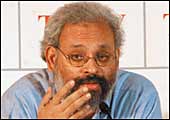 |
| Show me the money: (From L to R, top
row) NIPFP's I. Rajaraman, Finance Commission's S. Acharya,
CRISIL's S. Kokarn, IT & Communications Minister D. Maran,
India Today's Aroon Purie and AB Group's Ranade; (bottom) RGICS'
B. Debroy, India Today's Prabhu Chawla, J. Ramesh and Tata Group's
S. Roy |
Are companies in India finally opening
their purse strings after eight long years of near investment drought?
And if yes, can that boom be sustained? These and such other vexed
questions were hotly debated by six eminent economists of the Board
of India Today Economists (bite) at its recently concluded sixth
quarterly meeting in New Delhi. The panel was moderated by Jairam
Ramesh, Secretary (Economic Affairs Department), Congress Party,
and Dayanidhi Maran, it and Communications Minister, was the chief
guest.
The verdict was near unanimous: it is too early to pop the bubbly,
never mind that the front pages of financial dailies were full of
stories about fresh investments by Indian corporates. The six economists
were also not impressed enough with the better-than-expected economic
growth in the first five months of this fiscal (April to August),
when the Index of Industrial Production (IIP), an indicator of industrial
activity, jumped 7.9 per cent. "I would only be convinced of
a boom if I see 10 investments worth Rs 5,000-crore each this year.
But that's not happening," said Ajit Ranade, Chief Economist
at the Aditya Birla Group. Interestingly enough, the Mumbai-based
commodities giant itself has investment plans of Rs 20,000 crore
in Orissa and Gujarat over the next five years but, as Ranade pointed
out, most of the money would be spent on "de-bottlenecking",
that is streamlining existing capacities, rather than new ventures.
For Indira Rajaraman, RBI Professor at the National Institute of
Public Finance and Policy (NIPFP), an investment figure of Rs 60,000
crore a year-around 2 per cent of the GDP-or more alone would signal
a boom. But her real worry was that even in these good times, the
construction industry had reported a slowdown in the first quarter
of this year compared to the first quarter of last year. Bibek Debroy,
Director of the Rajiv Gandhi Institute of Contemporary Studies (RGICS),
trashed all suggestions of an investment boom, saying that it was
"exceedingly premature to talk of a boom on the basis of one
quarter results".
 |
 |
SUBIR GOKARN
Chief Economist, Crisil
GDP: 5.6%
INFLATION: 6%
INTEREST RATE: 6.5%
EXCHANGE RATE: Rs 46/$
JOB SCENARIO: Weak |
INDIRA RAJARAMAN
RBI Professor, NIPFP
GDP: 6%
INFLATION: 7%
INTEREST RATE: 7.5% EXCHANGE RATE:
Rs 46/$
JOB SCENARIO: Not bright |
 SHANKAR
ACHARYA SHANKAR
ACHARYA
Member, 12th Finance Commission
GDP: 5.5 to 6%
INFLATION: 6.5%
INTEREST RATE: 7.5% EXCHANGE RATE:
Rs 45-47/$
JOB SCENARIO: Weak |
Subir Gokarn, Chief Economist at the credit rating agency CRISIL
and one of the more optimistic experts on the panel, argued that
the huge 27 per cent jump in growth in machinery and equipment (a
fairly heavyweight in the IIP) in the first five months, compared
to zero or negative growth in September 2003, was clearly an indication
of investment, going by the strict definition of investment. "It
is certainly a positive indicator both from the short-term and long-term
growth perspective since it is contributing to demand," Gokarn
said.
The significant growth in this sector was not a strong enough
indicator, felt Shankar Acharya, Member, Twelfth Finance Com-mission
and former economic adviser to the Government of India. That growth
needed to be augmented with other positive signals such as substantial
growth in non-oil imports, particularly in the capital goods sector,
and enhanced credit flow from banks and domestic financial institutions
to the corporate sector, Acharya added. In effect, as Ramesh, Rajya
Sabha member and moderator of the bite panel, commented, though
there were some preliminary indicators of hope, it was too early
to dub it as a broad-based and sustainable revival.
But how does sustain this "nascent investment boom"?
Only through greater public sector investment, felt bite economists.
The reason, as Rajaraman of NIPFP pointed out, was that Indian corporates
were still hesitant of entering into areas like rural infrastructure,
where the returns on investments are either insufficient or too
risky. But getting public sector investment was easier said than
done, felt some of Rajaraman's co-panellists, since the states that
were responsible for making the investments, were either bankrupt
or badly stressed.
Rajaraman, however, felt that there were ways to circumvent the
problem of insufficient funds. The Central government could, she
suggested, either write-off the interest payments of the state thereby
allowing them to use that money for developmental purposes or open
an escrow account to be used only for creating real assets. Additional
funds, according to Rajaraman, could be generated by allowing the
Panchayats to tax agricultural income.
 SIDDHARTHA
ROY SIDDHARTHA
ROY
Chief Economist, Tata Group
GDP: 6%
INFLATION: 7%
INTEREST RATE: 7% EXCHANGE RATE:
Rs 46/$
JOB SCENARIO: Slightly better | | 